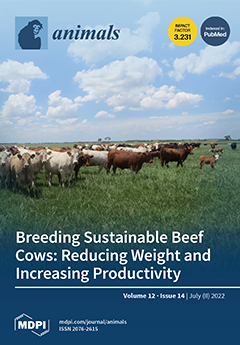Spats1 (spermatogenesis-associated, serinerich 1) has been characterized as a male-biased gene which acts an important role in the germ cell differentiation of mammals. Nevertheless, the function of
Spats1 in the Chinese soft-shelled turtle (
P. sinensis) has not yet been reported. To
[...] Read more.
Spats1 (spermatogenesis-associated, serinerich 1) has been characterized as a male-biased gene which acts an important role in the germ cell differentiation of mammals. Nevertheless, the function of
Spats1 in the Chinese soft-shelled turtle (
P. sinensis) has not yet been reported. To initially explore the expression of
Spats1 in
P. sinensis and its response to sex steroid treatment, we cloned the CDS of
Spats1 for the first time and analyzed its expression profile in different tissues, including the testes in different seasons. The
Spats1 cDNA fragment is 1201 base pairs (bp) in length and contains an open reading frame (ORF) of 849 bp, which codes for 283 amino acids.
Spats1 mRNA was highly expressed in the testes (
p < 0.01) and barely detectable in other tissues. In
P. sinensis, the relative expression of
Spats1 also responsive to seasonal changes in testis development. In summer (July) and autumn (October),
Spats1 gene expression was significantly higher in the testes than in other seasons (
p < 0.05).
Spats1 mRNA was found to be specifically expressed in germ cells by chemical in situ hybridization (CISH), and it was mainly located in primary spermatocytes (Sc1), secondary spermatocytes (Sc2) and spermatozoa (St).
Spats1 expression in embryos was not significantly changed after 17α-methyltestosterone (MT)and 17β-estradiol (E2) treatment. In adults, MT significantly induced
Spats1 expression in male
P. sinensis. However, the expression of
Spats1 in testes was not responsive to E2 treatment. In addition, the expression of
Spats1 in females was not affected by either MT or E2 treatment. These results imply that
Spats1 is a male-specific expressed gene that is mainly regulated by MT and is closely linked to spermatogenesis and release in
P. sinensis.
Full article






